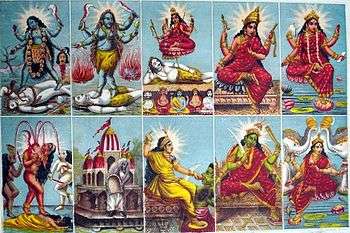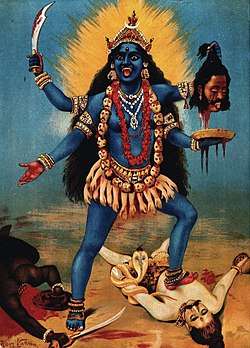Mahavidya

Chhinnamasta, Dhumavati, Bagalamukhi, Matangi & Kamala . Consort - Shiva.
Mahavidyas (Great Wisdoms) are a group of ten aspects of Adi Parashakti in Hinduism. After the decline of Buddhism in India, Sakta and Buddhist goddesses were combined to form this list of ten.[1]
The development of Mahavidyas represents an important turning point in the history of Shaktism as it marks the rise of Bhakti aspect in Shaktism, which reached its zenith in 1700 CE. First sprung forth in the post-Puranic age, around 6th century C.E., it was a new theistic movement in which the supreme being was envisioned as female. A fact epitomized by texts like Devi-Bhagavata Purana, especially its last nine chapters (31-40) of the seventh skandha, which are known as the Devi Gita, and soon became central texts of Shaktism.[2]In a story from the Shakta Maha-Bhagavata Purana, which narrates the creation of all the Mahavidyas, Sati, the daughter of Daksha and first wife of god Shiva, feels insulted that she and Shiva are not invited to Daksha's yagna ("fire sacrifice") and insists on going there, despite Shiva's protests. After futile attempts to convince Shiva, the enraged Sati transforms into the Mahavidyas, who surround Shiva from the ten cardinal directions.
Etymology

The name Mahavidyas comes from the Sanskrit roots, with maha meaning 'great' and vidya meaning, 'revelation, manifestation, knowledge, or wisdom.[2]
Stories
The Dasha Mahavidyas are a group of ten Tantric forms of Adi Shakti, the Supreme Goddess. They range from extremely fierce and malevolent to extremely benign and benevolent aspects of the Supreme Goddess.
These Mahavidyas had come into existence when Daksha has invited all men, sages, Gods and Goddesses to his sacrificial Yajna, except for Mahadev and his first wife, Goddess Sati. When Sati learned about her father holding the Yajna, she went to her husband and expressed her desire to go. However, Mahadev disapproves, saying that it will be unlawful to Daksha and will cause disaster if they go. Hearing this, Sati was enraged that her husband was not treating her like she was the embodiment of the Supreme Goddess. To show her husband her true omnipotence, Sati transformed herself into ten different Goddess forms, each surrounding her husband from the ten directions. Mahadev was frightened to see that his wife had multiplied herself into these forms.
Mahadev wondered where his wife, Sati had disappeared to and is very worried seeing the ten Mahavidyas surrounding him from the ten directions. Gathering the courage and fearlessness to ask the ten Supreme Goddesses barring his every escape route, he reverently bowed down to each and every one of them and he enquired them their names, and significance. One by one, the Mahavidyas enlightened Mahadev about the embodiment of their forms, abilities as well as capabilities.
Hearing these descriptions of the ten Mahavidyas, Mahadev was enlightened and paid his gratitude to them, but he still asked them about his wife Sati as to where she is. Then the Mahavidyas, altogether told him that his wife Sati is within every one of them as they are her ten forms, and that they are all his wives and are all with him in his different forms. Ultimately, Mahadev finally allows Sati to go to the Yajna held by her father, subsequently freeing herself from the Goddesses. However, at the Yajna, due to Daksha's vulgar words for Mahadev, Sati resolved to quit her body by setting herself on fire. There is another story of the origin of the Mahavidyas, but this time, with Shiva and his second wife, Parvati, the reincarnation of Sati.
Shiva and Parvati are believed to have played numerous love games with each other. On one such occasion, things went a bit too far with a mock fight, with Shiva threatening to walk out on Parvati. The Devi tried to cajole her Lord into not leaving her. But Shiva refused to listen to her and tried to move away from her. Parvati then took ten different forms of herself, each guarding one of the ten directions. Thus Shiva was unable to escape from her, as he would find one aspect of her standing in each of the directions he turned, guarding it, preventing him from escaping. This made Shiva realize the true degree of their eternal love and also, that Shakti's power was much superior to his own. The Devi demonstrated her own endless powers to Shiva, also making him realize many essential truths in the process.
Names
Shaktas believe, "the one Truth is sensed in ten different facets; the Divine Mother is adored and approached as ten cosmic personalities," the Dasa-Mahavidya ("ten-Mahavidyas").[3] The Mahavidyas are considered Tantric in nature, and are usually identified as:[4]
- Kali – The ultimate form of Brahman, "Devourer of Time" (Supreme Deity of Kalikula systems).
- Tara – The Goddess as Guide and Protector, or Who Saves. Who offers the ultimate knowledge which gives salvation. She is the goddess of all sources of energy. The energy of the sun is also a grant from her.
- Tripura Sundari (Shodashi) – The Goddess Who is "Beautiful in the Three Worlds" (Supreme Deity of Srikula systems); the "Tantric Parvati" or the "Moksha Mukta".
- Bhuvaneshvari – The Goddess as World Mother, or Whose Body is the Cosmos.
- Bhairavi – The Fierce Goddess.
- Chhinnamasta – The self-decapitated Goddess[5].
- Dhumavati – The Widow Goddess, or the Goddess of death.
- Bagalamukhi – The Goddess Who Paralyzes Enemies.
- Matangi – the Prime Minister of Lalita (in Srikula systems); the "Tantric Saraswati".
- Kamala – The Lotus Goddess; the "Tantric Lakshmi".
The Mahabhagavata Purana and Brhaddharma Purana however, list Shodashi (Sodasi) as Tripura Sundari, which is simply a different name for name for the same goddess.[6] The Guhyatiguyha-tantra associates the Mahavidyas with the ten Avatars of Vishnu, and states that the Mahavidyas are the source from which the avatars of Vishnu arose. All ten forms of the Goddess, whether gentle or terrifying, are worshiped as the universal Mother. All ten forms of the Goddess is concluded and worshipped in the Sri Chakra and Tripura Sundari is considered as the Adi Parashakti.
References
- ↑ Sanderson, Alexis. "The Śaiva Literature." Journal of Indological Studies (Kyoto), Nos. 24 & 25 (2012–2013), 2014, pp. 80.
- 1 2 Brown, Charles Mackenzie (1998). The Devī Gītā: The Song of the Goddess. SUNY Press. p. 23. ISBN 9780791439401.
- ↑ Shankarnarayanan, S (1972). The Ten Great Cosmic Powers: Dasa Mahavidyas (4 ed.). Chennai: Samata Books. pp. 4–5. ISBN 9788185208381.
- ↑ Kinsley, David R (1997). Tantric Visions of the Divine Feminine: The Ten Mahavidyas. Berkeley: University of California Press. p. 302. ISBN 9780520204997.
- ↑ Daniélou, Alain (1991). The Myths and Gods of India: The Classic Work on Hindu Polytheism from the Princeton Bollingen Series. Inner Traditions / Bear & Co. pp. 284–290. ISBN 978-0-89281-354-4.
- ↑ Kinsley, David R (1987). Hindu Goddesses: Vision of the Divine Feminine in the Hindu Religious Tradition. Motilal Banarsidass Publication. pp. 161–165. ISBN 9788120803947.
External links
| Wikimedia Commons has media related to Mahavidya. |

